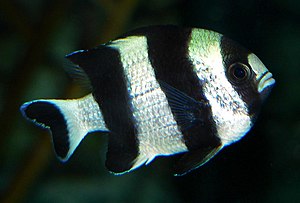Prussian fish
| Prussian fish | ||||||||||||
|---|---|---|---|---|---|---|---|---|---|---|---|---|

Four-banded Prussian fish ( Dascyllus melanurus ) |
||||||||||||
| Systematics | ||||||||||||
|
||||||||||||
| Scientific name | ||||||||||||
| Dascyllus | ||||||||||||
| Cuvier , 1829 | ||||||||||||
The Prussian fish ( Dascyllus ) are a genus of damselfish that consists of eleven species .
The animals live in the tropical coral reefs of the Indo-Pacific and the Red Sea in a commensal relationship to knotty hard corals that serve as cover. Prussian fish feed on zooplankton .
Reproduction
The animals usually lay over a thousand eggs on solid ground. The parent animals care for and defend the clutch. After hatching, the tiny larvae live pelagic for a while and spread with the ocean currents. If the fish transform to adult form, they seek shelter in hard coral colonies.
The Hawaiian Prussian fish, Strasburg's Prussian fish and the three-point Prussian fish sometimes live like anemonefish in symbiotic anemones as young fish .
Prussian fish can easily be kept in marine aquariums, but they often become very aggressive. Only the Red Sea Prussian fish and the four-banded Prussian fish are recommended pets.
The three-banded Prussian fish and another species have also been bred.
Systematics
There are eleven types:
- Dascyllus abudafur (Forsskål, 1775)
- Hawaiian Prussian Fish ( Dascyllus albisella ) Gill, 1862
- Three-banded Prussian fish ( Dascyllus aruanus ) (Linnaeus, 1758)
- Dascyllus auripinnis Randall & Randall, 2001
- White-tailed Prussian fish ( Dascyllus carneus ) fisherman, 1885
- Dascyllus flavicaudus Randall & Allen, 1977
- Red Sea Prussian fish ( Dascyllus marginatus ) (Rüppell, 1829)
- Four-banded Prussian fish ( Dascyllus melanurus ) Bleeker, 1854
- Net Prussian fish ( Dascyllus reticulatus ) (Richardson, 1846)
- Strasburg's Prussian fish ( Dascyllus strasburgi ) Klausewitz, 1960
- Three-point Prussian fish ( Dascyllus trimaculatus ) (Rüppell, 1829)
Trivia
In the animated film Finding Nemo from 2003, the four-banded Prussian fish Lee & Luv appears in a supporting role .
literature
- Gerald R. Allen : Damselfish of the World , Mergus Verlag Melle, 1991, ISBN 3-88244-007-4
- Hans A. Baensch / Robert A. Patzner: Mergus Sea Water Atlas Volume 7 Perciformes (Perch-like) , Mergus Verlag, 1998, ISBN 3-88244-107-0 .
Web links
- Prussian fish on Fishbase.org (English)

